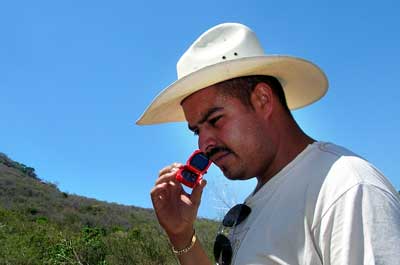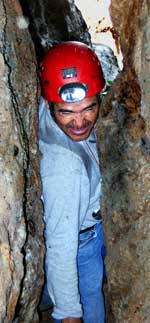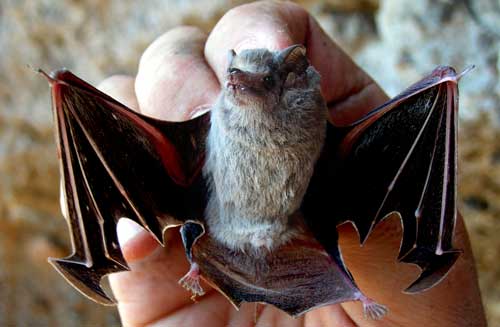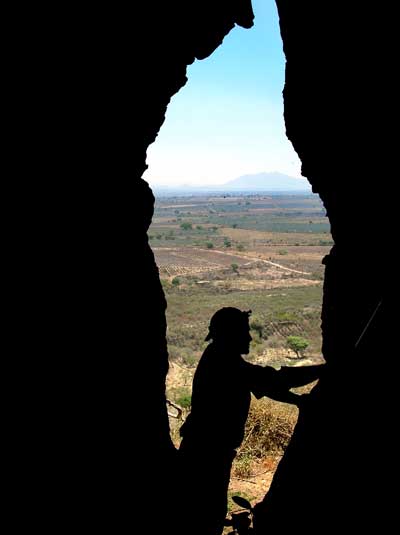|
On June 3, 2010, Ezequiel Garcia invited us to visit two caves
he had heard about, not far from Amatitán. “Us” in this case
meant Leonel Ayala of Filostoc, Luis Rojas and John Pint of Zotz,
and David Andrade, a caver newly arrived in this area, now
living in Ahualulco.
We followed Ezequiel and a friend along a dirt road for about 20
minutes and parked. Our guides pointed to a hill in the
distance. “There’s the first one,” they said. “It’s at the top
of that hill.”
Well, that hill looked pretty far
away and mighty high and I
thought, “Hmm…I don’t think we’re going to be visiting two caves
today, especially in this heat (It’s hottest in this part of
Mexico just before the rainy season starts).
 So we walked about half an hour and stopped to rest under a
shady tree. Ezequiel whipped out his cell phone and began a long
conversation with much gesticulating and pointing. So we walked about half an hour and stopped to rest under a
shady tree. Ezequiel whipped out his cell phone and began a long
conversation with much gesticulating and pointing.
“Ahem,” I whispered to Rojas, “It looks like Ezequiel has never
been to the cave… this will mark the first time we have hunted
for a cave by a remote guidance system.”
“Guess what?” said Ezequiel. “The cave is not on that mountain
at all. It’s next to that smaller hill over there.”
This could be interpreted as good news, but for the fact that
the only way to get to the other hill required cutting across
numerous rows of tequila agaves, which are always planted very
close to one another in one direction and just far enough apart
for (very careful) walking in the other direction. The agave
leaves, of course, are tipped with a spike that used to serve as
a sewing needle in the past and it has microscopic barbs on it
which guarantee pain for days.
Now, as we began to cut across the field, “in the wrong
direction, agave-wise,” we discovered that the spaces between
the agaves were filled with:
A. Dominguilla (a kind of stinging nettle)
B. Thorns
In addition, every patch of agaves was
surrounded by a barbwire fence which we had to crawl over, under
or through. So, the most spoken word during this portion of the cave hunt
was ¡Ay! from my companions and ouch! From me.
At last, well scratched and well pricked, we came to a kind of
sheltered indentation in a smooth, undulating wall of hill
number two. It was quickly determined that there was no cave
anywhere along this wall, and out came the cell phone again,
with lots of arm-waving and endless attempts to describe what we
were seeing versus what we should be seeing (come on, Nokia, we
need a videocam in these things!).
“Entonces,” said Ezequiel at long last. “The cave is not here
(which we had already figured out), but it’s at the base of the
next hill, over there.”
Well, dear reader, I imagine you can guess what was between us
and the next hill. Yes, more rows of agaves to be crossed
wrongly, more thorns, and this time a veritable forest of evil
dominguilla plants.
Finally, after a mere two hours of ¡Ay!s and ouch!es, we arrived
at the cave: a long, high, very narrow crack. Our noses
immediately informed us that there was plenty of guano de
murciélago inside, which brought joy to the face of our bat
expert, Leonel.
 Those of us who first took a look at the cave, found it narrowed
to a gap that only a Sonia could squeeze through standing up
(the pre-ice-cream-bar Sonia, of course). For us normal cavers
(with panzas) the way forward meant throwing ourselves on the
ground and crawling on our bellies for a meter or two, at which
point we ran into a veritable cloud of little black bugs
guarding the passage. Those of us who first took a look at the cave, found it narrowed
to a gap that only a Sonia could squeeze through standing up
(the pre-ice-cream-bar Sonia, of course). For us normal cavers
(with panzas) the way forward meant throwing ourselves on the
ground and crawling on our bellies for a meter or two, at which
point we ran into a veritable cloud of little black bugs
guarding the passage.
If you managed to get through the bugs without swallowing any,
you came to a climbable vertical wall, sixteen meters from the
entrance. Here, anyone who wanted to could proceed upward for
9.2 meters, which gets you to the top of the crack and the home
of the bats. Up here Leonel found Grey Sac-Winged Bats (Balantiopteryx
plicata) which also live in relatively nearby Cueva Cuata (Tequilizinta).
There were lots of these as well as signs of a few vampire-bat
visitors too. The temperature inside, by the way, was 27°C,
humidity 71%.
Exploring and mapping this cave took only a tiny fraction of the
time it took to locate it, which, to some, might suggest it was
rather small and insignificant, but, of course, in comparison to
those Manantlán caves recently found by Sergi Gómez, Cueva de
los Moscos should probably be listed among the major caverns of
Jalisco.

A Grey Sac-Winged Bat (Balantiopteryx
plicata)

Besides bugs 'n' bats, this cave also features a nice view. |



